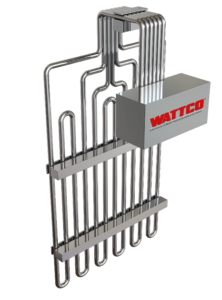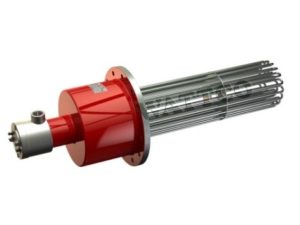Immersion Heater Application in Colder Climates
Last updated on May 7th, 2025 at 04:41 am
Immersion heaters offer key advantages in colder climates. This is due to their high power density, compact size and ability to be installed in existing infrastructure. As a result, they are found in numerous applications where arctic and subarctic environmental conditions are common.
Electric immersion heaters are commonly regarded as a fast, economical, and efficient method of industrial heating. Common applications include heating up liquids in tanks, pressure vessels, and drums. They are also used for direct heat application or as a part of a heating loop in case the process fluid is too corrosive for direct contact with the immersion heaters.
Also known as bayonet heaters, their high energy density results in liquid reaching the desired temperature quickly. This article discusses a few common applications of immersion heaters in colder environmental conditions.
Immersion heaters for Tank Heating
 The colder climate brings the challenge of effectively heating the process fluid. Left unchecked, this results in costly shutdowns and equipment failures.
The colder climate brings the challenge of effectively heating the process fluid. Left unchecked, this results in costly shutdowns and equipment failures.
Common types of immersion heaters used for tank farm heating are flanged immersion heaters. Most of the greenfield expansion tank farms are designed with the flanged immersion heater although in some non pressured examples screw-type immersion heaters are also common.
Over the side immersion heaters are more common for brownfield installations where existing infrastructure does not allow the installation of flanged or screw plug immersion heaters. This allows for liquid to reach temperatures above the freezing point in colder climates. However, the process temperature must not be solely determined by the freezing point of the liquid. Crystallization and viscosity changes begin above the freezing temperature. So these factors must be accounted for when setting the operating temperature.
Insulation
Another aspect of tank heating is tank insulation which plays an important role in the retention of heat in the tank. In some cases of tank heating, inline heaters are also common where fluid is drawn from the tank, heated in a separate chamber with one or more immersion heaters, and directed back to the tank. Such inline heaters can be mounted on a skid for additional flexibility for quick installation and removal.
When selecting the immersion heater for tank heating application the sheath material, watt density (W/cm2), maximum operating temperatures, and plug material are carefully chosen to ensure maximum longevity and optimization of the total cost of ownership (TCO).
For potable water the recommended sheath material is usually copper. The typical plug material is brass at maximum operating temperatures of 100°C with neutral pH (pH 6 to 8). For mildly acidic and weak acidic solutions the maximum operating temperatures are 100°C and 80°C respectively. For both applications recommended sheath material is nickel alloys (Incoloy®) or SS316 or SS304.
For Crude oil and petrochemical applications like fuel oil 1& 2, kerosene lube oil (SAE 10 to 20) and lube oil (SAE 40 to 50) the recommended sheath and plug material is steel while maximum operating temperatures are much higher 95°C to 120°C. In most of the cases manufacturer of the immersion heaters shall be consulted for appropriate material selection.
Immersion Heaters for Cooling Towers
 Cooling towers are commonly used in the chemical and petrochemical industry for large-scale cooling of cooling water used in the process. In sub-zero temperatures, a method of heating the cooling water just above the freezing point is required.
Cooling towers are commonly used in the chemical and petrochemical industry for large-scale cooling of cooling water used in the process. In sub-zero temperatures, a method of heating the cooling water just above the freezing point is required.
Anti-freeze cannot be used in the open circulating tower so electric immersion heaters are more commonly being used to heat the cooling water circuit above the freezing temperature and just because they are always fully immersed and in direct heating application they are 100% efficient in transferring the heat to the cooling water.
The electric immersion heaters in the cooling tower basin are meant for protecting the water at the basin from freezing and do not offer any protection to the piping or the fill. For heating the piping usually heat trace is required.
There are few factors to consider when selecting the sheath material for the electric immersion heater because the cooling towers are subjected to prolonged durations of stagnant water with innate chemical treatment which can act as a catalyst to the corrosion of the sheath material. Usually, copper or SS304 are used for <50 watt/in2 (smaller applications) and SS304 is used for >50 watt/inch2 or the large-scale cooling tower application. Large multi-cell cooling towers have long cartridge heaters with SS304 sheath material for better heat distribution across the Cooling tower basin.
Controller
The digital control panel should maintain the temperature above the freezing temperature. As well, it should have a low level cut-off in case the basin water level falls below the immersion heater. The mounting positions are usually determined by the cooling tower design with 2 or 2-1/2” NPT ports already built at the basin for horizontal insertion of the immersion heater above the sump sludge level. Screw plug immersion heaters are preferred in the cooling tower application.
A rule of thumb is that the water level shall be 2” above the immersion heater and the immersion heater shall be 2” above the basin floor.
Also read: Cooling Towers in Cold Climates
Immersion heaters for diesel engines
Gelling and freezing up is a common problem for diesel engines operating in colder temperatures. One of the most effective ways for heating the diesel engine is an electric immersion heater. The heater is powered by the AC in the diesel engine block to heat the fluid.
There are four common types of electric immersion heaters used in diesel engines to heat the coolant so that engine can start in colder temperatures:
- Threaded immersion heaters
- Bolt-on style immersion heaters
- Cartridge immersion heaters
- Freeze plug (v-lock) immersion heaters
Most of the immersion heaters used in diesel vehicles have copper elements for heat transfer. Cartridge immersion heater doesn’t require to drain coolant during installation while other styles require draining of coolant for installation.
Drum Heaters
Drums for various liquids, especially in crude oil storage, need to be heated in colder temperatures to maintain the flow viscosity of the fluid. Most commonly used are over the side immersion heaters with NEMA rated terminal enclosure and thermostat or thermocouple with temperature control. In such configurations the electric immersion heater can operate at a maximum temperature of 121°C.
